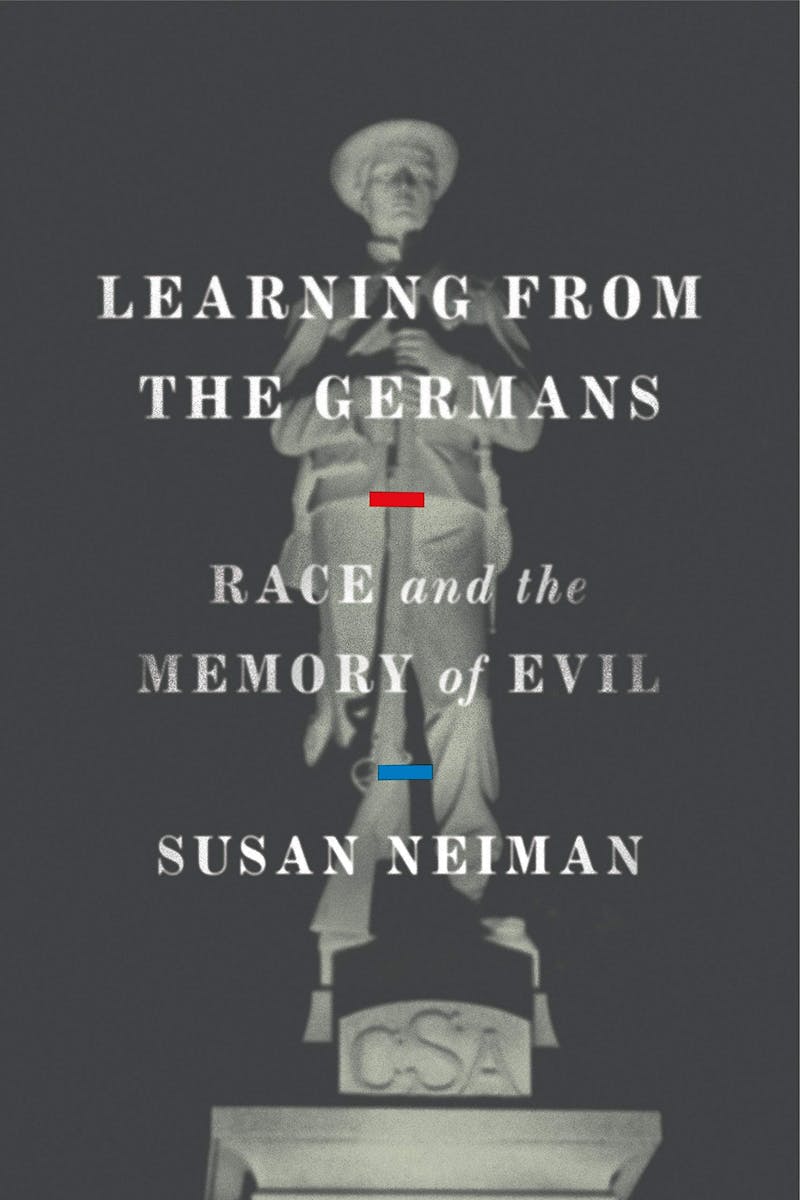Neiman also allows herself one “clear and simple thesis: East Germany did a better job of working off the Nazi past than West Germany.” Whatever the sins of the East German surveillance state, it succeeded in the five “crucial facets of any successful attempt to work off a nation’s criminal past: (1) “achieve a coherent and widely accepted national narrative”; (2) reinforce that narrative with symbols and memorials consistent with that narrative, paying homage to victims rather than perpetrators; (3) standardize the national narrative through education; (4) incorporate the narrative into the nation’s music, specifically the national anthem; and (5) enshrine this new narrative in concrete action, for example through reparations and by prosecuting perpetrators, something both governments did, but with East German Nazi prosecutions far more extensive.
“Antifascism by decree,” as Westerners called it, worked. It may well have been a tool, both for Germans “to win favor with the Soviet occupiers” and for the East German state “to conceal its own injustice and repression,” but ultimately it did spread a strong anti-fascist message. Almost immediately after the war, East Germany raised memorials to Germany’s victims—Neiman focuses particularly on the memorial to fallen Soviet soldiers at Treptow, in East Berlin. Such memorials, like the Nazi prosecutions, may have been imposed from the top down, but they resulted in changes of sentiment as well. Friedrich Schorlemmer, an East German Lutheran pastor she talks to, “finds the Treptow monument more moving than the Holocaust Memorial [erected after reunification]… He can still get teary when he hears the line from the former national anthem: “Never again shall a mother have to mourn her son.”
Neiman then turns to Mississippi, a Confederate state with high antebellum wealth concentrations and the site of appalling twentieth-century racial violence: the lynching of Emmett Till in 1955, the attempt to prevent the integration of the University of Mississippi in 1962; and the murder of the three civil rights workers in 1964.
Mississippi, like Germany in World War II, was scarred by the Civil War and thus ill-inclined to consider the guilt on its own side. Within the state, where Neiman lived for a year while researching this book, Neiman first focuses on Oxford and the University of Mississippi, which in 1962 hosted “what’s been called the last battle of the Civil War”—Governor Ross Barnett and rioting students trying to prevent James Meredith from becoming the first black man to study at the university. There, she talks to employees at the Winter Institute for Racial Reconciliation about their ongoing attempt to begin a racial reckoning in the American setting.
The Winter Institute’s Welcome Table program brings together racially mixed groups for monthly meetings over a year and a half—first focusing on building trust, then discussing tougher matters, including first childhood memories of race as an issue and the difference between systemic and intentional, personal racism. Part of what makes the approach work, Neiman writes, is the Institute’s insistence on “the humanity of the perpetrator as well as the victim,” in order to build “the trust needed to talk directly about racism, past and present.” “When you’re listened to,” one staff member tells Neiman, “no matter what your identity is, you feel valued, and you’re more open to engage in conversations that get deeper and deeper.”
Neiman perceives ample evidence in Mississippi for her thesis—that lack of reckoning with the past is indeed responsible for our fraught present. She asks another employee at the Winter Institute “why so many white Southerners hate President Obama. Her answer was swift; she had no need to speculate. ‘I’ve had two white men tell me they’re afraid he’ll take revenge for all the things whites did to black people.’”
The Winter Institute’s work, Neiman argues, runs counter to the way Mississippi is inclined to approach its history—which, her interviewees say, is primarily to avoid it. Attempts to install museums and memorials to the state’s black victims, she shows, have proceeded slowly and with great controversy: Tallahatchie County’s apology and memorial to Emmett Till’s family took decades, and only materialized after much negotiation in 2007.
Neiman aims to encourage American efforts at a grim time. It might be easy for a critic to argue that Americans have already missed the Vergangenheitsbewältigung boat: If Germans managed to confront their past in the Wehrmacht exhibit 50 years after the “zero hour” of World War II’s conclusion, is there really much hope for Americans, 154 years after Lee’s surrender? But this, Neiman holds, is the wrong timeline to be looking at: Americans are only now in the early stages of their reckoning, for the simple fact that the Civil War did not really end in 1865. Due to Reconstruction, due to Jim Crow, and as evidenced by the appalling violence and state-federal standoffs of the 1960s, the appropriate point to mark the South’s “zero hour,” she believes, is not 1865 but 1964, with the passage of the Civil Rights Act. According to this timeline, Americans are a bit behind the Germans, but not by much—“about the place where Germany was when the Wehrmacht Exhibit provoked the kind of backlash that the removal of Confederate monuments provoked in New Orleans.”
This idiosyncratic degree of optimism—treating a century and a half of intransigence as evidence that Americans can evolve—is deliberate. The book is a compare and contrast in two case studies. But it’s also, as Neiman acknowledges, undergirded by a broader idea most often associated with Enlightenment-era thinking: that history is fundamentally progressive—things get better over time. Germany is better now than it was in the 1980s. And as for the United States, the current moment itself is in part a reflection of the progress of the Obama era: “Racist violence,” she posits, “occurs most often when black people advance.”
Comparing German and American attempts to reckon with the past is a worthy exercise: Despite well-documented imperfections and blindspots, Germany has clearly managed something unusual in international history. German accountability for the Holocaust has far surpassed U.S. attempts to acknowledge either slavery or genocide against Native Americans; Turkish denial of the Armenian genocide; Russian denial of Stalin’s deliberate starvation of Ukraine; Austrian, Polish, and French minimization of their own uncomfortably complicit role in the Holocaust; or patchy Japanese acknowledgement of atrocities in China, to name but a few counterexamples. And anything that can be gleaned from studying the German example—as well as anything that can be gleaned from looking at where it did not succeed—is worth considering.
The particulars of such a task, however, are far from easy, and Neiman’s specific conclusions lean eccentric. Neiman says several times in her introduction that she is not a historian, and indeed the book is more persuasive at a theoretical and intuitive level than at an empirical one. There are a few notable omissions—for example, in the section praising the Treptow monument to fallen Soviet soldiers, she fails to discuss the mass rape suffered by German women at the hands of the Red Army. Knowing that the Red Army raped untold numbers of German women, does the monument to fallen Soviet soldiers in East Berlin really represent a society coming to terms with history? Or does it represent a particularly grisly form of forgetting? Despite the conspicuous and brief decriminalization of abortion in the Soviet occupation zone, postwar Germans in both the East and West mostly refused to listen to female narratives of wartime rape. How does that square with one of the supposed lessons of the reckoning process in both Germany and Oxford, Mississippi—that people must feel their trauma is acknowledged before acknowledging their own guilt in the traumas inflicted on others?
In Neiman’s narrative of the East’s and West’s different paths to historical reckoning, her desire to rehabilitate (with somewhat good reason) the East skims over a number of complicating factors, some big, some small. If one is to contend that East Germany, despite its authoritarian approach, “did a better job of working off the Nazi past than West Germany,” one needs to grapple with the fact that the present-day right-wing nationalist Alternative für Deutschland party is proportionally particularly popular in the East—suggesting that top-down memorialization initiatives don’t necessarily inoculate a society against a resurgence of racism.
This wrinkle points to another factor in the long-term success of a historical reckoning, which Neiman mentions in passing but never fully explores: the state of the economy. West Germany has been blessed with relative economic prosperity since World War II, but the East less so—much like the American South. (Economists, naturally, tend to like such explanations, pointing to data suggesting economic expansion on its own increases tolerance, while economic slowing or contraction increases inter-group tensions.) While one shouldn’t oversimplify or use GDP numbers to negate personal responsibility, economic conditions are an important part of the postwar German and American stories, and easily overlooked in personal interviews that disproportionately—although not exclusively—feature members of the intelligentsia.
Inattention to economic context also complicates an otherwise very persuasive case for reparations. “It cannot be too much to expect the U.S. Congress to do in the twenty-first century what the German parliament did in 1952,” Neiman writes. Ethically, that’s true. Practically, however, the two moments are wildly different. West Germany, in 1952, was not just in the middle of a post-war boom, but had also received nearly $1.5 billion from the Marshall Plan in the three preceding years, and was spending nothing at all on military—the Wehrmacht had been abolished in 1946, with the Allies effectively taking charge of defense responsibilities, and the new, limited military, the Bundeswehr, would not be established until 1955. It was as close to a fiscally unique situation as one can imagine—and even then, Adenauer’s decision to support reparations was met with a great deal of hostility. As the richest country in the world, the United States can afford reparations. But if the point is to “learn” from the German example, what, exactly, should a country perpetually deadlocked on budgetary issues learn from the highly unusual example of West Germany in 1952?
Most importantly, the idea that Trump’s presidency rests on Southern denial—however intuitively persuasive—skates past some pesky particulars. While Trump did win ten out of eleven of the former states of the Confederacy, the non-Confederate states of California, Pennsylvania, Ohio, New York, Michigan, and Illinois count among the top-ten Trump spots by total voters. What should we make of the 32 percent of Latino men who voted for Trump in 2016? Or the fact that if all Obama voters had turned out for Hillary Clinton, Trump would have lost the election? Trumpism in the United States goes beyond any single form of bigotry. Racism in the United States goes beyond the mere legacy of slavery. (Just look at how northern abolitionists wrote about the black people they claimed to champion, at white opposition to public school integration in the present, or at a research paper published this past September finding that Southern states do not necessarily have the highest levels of racial resentment in the country.) Addressing racial inequality and injustice in the United States today is a much larger task than Neiman seems to propose.
History is not the story of a one-way journey towards “progress,” and events are not necessarily comparable because they look alike. It does not necessarily follow that one community can adopt the model provided by another—something Neiman acknowledges in several caveats, but elsewhere seems to reject outright. Ultimately, “this book itself is offered as an exercise in universalism, in the hope that understanding difference will help us find shared souls,” she writes. Germany may not be able to offer a prescription for Americans, but the comparison, Neiman says, may offer “hope.”
In the midst of a backlash to a presidency that had explicitly adopted “hope” as a slogan, that may ring hollow to some readers. Historical reckoning does not necessarily proceed by numerology: The fact that Germans took about half a century to come to terms with Nazism (and, surely, it’s far too early to say whether this or any other social trend is permanent) needn’t suggest Americans are approaching a similar period of progress. And the fact that the United States took until 1964 to enshrine the legal reforms that should have happened at the end of the Civil War is not an explanation for its delayed reckoning, but a historical question in its own right. If the Civil War did not end until the Civil Rights Act, and the American reckoning clock thus only started in 1964 as compared to Germany’s 1945, surely the most relevant question is not “why is the American version of the Wehrmacht exhibit ten years late” but “why did the Holocaust last six years and America’s enslavement, disenfranchisement, segregation, and lynching of black people last three hundred and forty-five?” Moreover, dating the active period of America’s racial trauma from 1619 to 1964 doesn’t account for the fact that black people are still killed by the American state and its representatives, through the death penalty and police shootings, at rates far exceeding white people in similar situations—something that has not been similarly true of Jews and the German state since 1945.
The United States’ debate about its own past is enriched by books like this one, and it could use another ten like it. But in the courageous work of building a better world, grim realism can be as useful a tool as optimism. A progressive view of history, human society faltering but measurably advancing towards a better future, is always at risk of seeming deterministic, and thus lulling us into a false sense of security about the amount of grueling, uncertain work needed to make the world a better place. The current American political moment—regardless of whatever happened in Germany in the 1990s—is entirely ours to fix.







/i.s3.glbimg.com/v1/AUTH_59edd422c0c84a879bd37670ae4f538a/internal_photos/bs/2019/i/y/biA3tvQ7iUBBDvh5GWLw/ctuhm-crescimento-da-informalidade.png)


/i.s3.glbimg.com/v1/AUTH_59edd422c0c84a879bd37670ae4f538a/internal_photos/bs/2018/o/V/Flfo1XTdm14vbYKPfuDw/volantes-loterias-q98a7863-credito-marcelo-brandt-g1.jpg)




